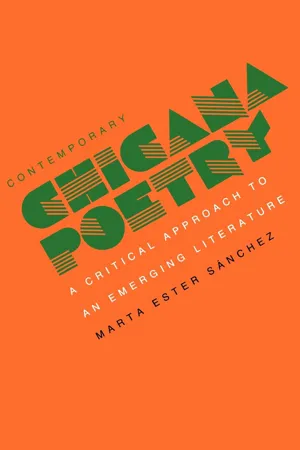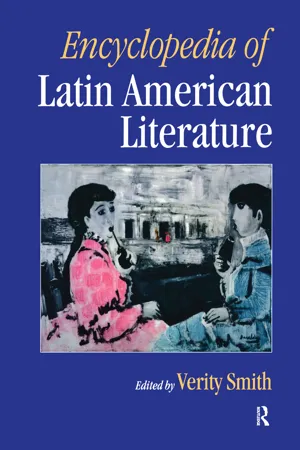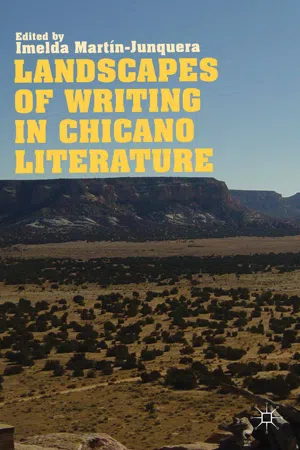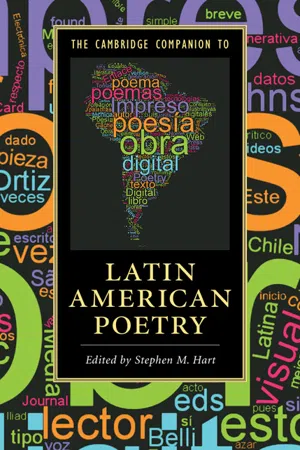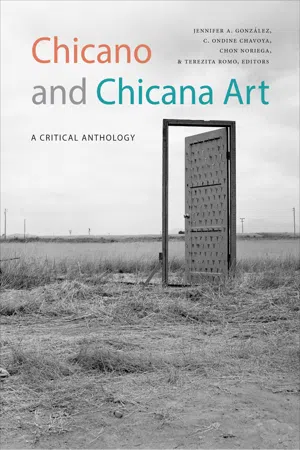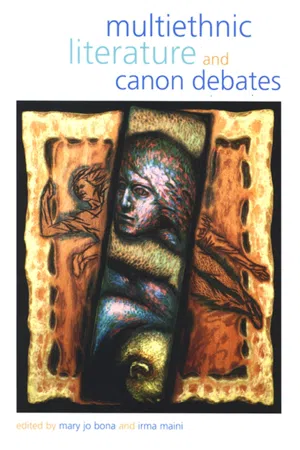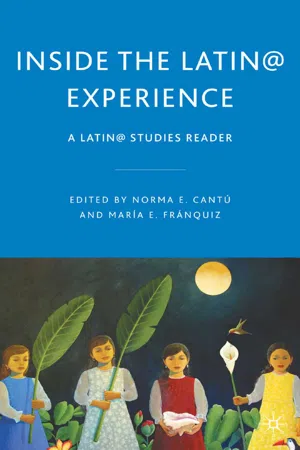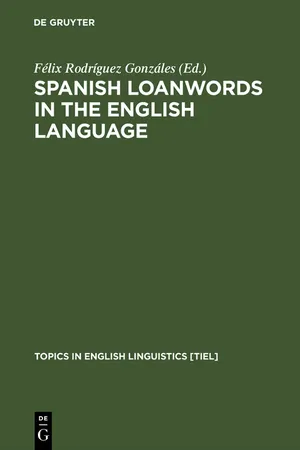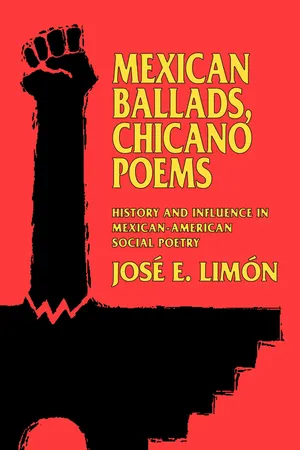Literature
Chicano Poetry
Chicano poetry refers to the body of literature written by Mexican Americans in the United States, often exploring themes of identity, culture, and social justice. It emerged as a powerful form of artistic expression during the Chicano Movement of the 1960s and 1970s, and continues to be a significant voice in American literature, offering unique perspectives on the experiences of the Chicano community.
Written by Perlego with AI-assistance
Related key terms
1 of 5
11 Key excerpts on "Chicano Poetry"
- eBook - PDF
Contemporary Chicana Poetry
A Critical Approach to an Emerging Literature
- Marta E. Sanchez(Author)
- 2023(Publication Date)
- University of California Press(Publisher)
Chicanos, an anthol- ogy published by a major press in Mexico and compiled by the poet Tino Villanueva, introduces Chicano and Chicana poets who write in Spanish to Mexican audiences. 28 A more recent anthol- ogy, Fiesta in Aztlan, presents thirty-three poems, mainly by men, in categories of the family, the barrio, and the universe. 29 Two poets, Lorna Cervantes and Gary Soto, who write poetry for English-speaking audiences, have been published by the Univer- sity of Pittsburgh Press. As most of the poetry of the late 1960s and the 1970s was 16 SETTING THE CONTEXT presented in limited editions by small publishing houses or in community journals, poems by Chicanas are now not easily avail- able to the larger mainstream audience. I therefore include all the poems I analyze in their entirety. Because Zamora's writing in- cludes Spanish, I provide translations of entire poems when neces- sary. For other poets I translate certain words or phrases so as to eliminate any possible difficulty for non-Spanish readers. POETRY: THE CHOSEN FORM OF EXPRESSION Like their male counterparts, Chicanas, with few exceptions, have chosen poetry and short prose as their primary media of expression. More prolific in poetry than in short prose, Chicanas chose to write poetry in the 1970s for the same reasons that Alurista, José Montoya, Tino Villanueva, and Raul Salinas wrote poetry in the late 1960s. During the 1960s and 1970s poetry was better able to meet the needs of the Mexican-Chicano commu- nity, which urgently wanted to redefine its relationship to Amer- ican society and concomitantly to explore its own cultural roots. Of prime importance were three factors: communication of the message, time, and money. In the early phase of the Chicano movement, poetry may be regarded as having functioned in the same way the coirido functioned in earlier decades in the Mexican Southwest. - eBook - PDF
- Nicolás Kanellos(Author)
- 2008(Publication Date)
- Greenwood(Publisher)
Randall G. Keller has identified a body of work that consists of scores of poems that are clearly related along a number of dimensions—both thematic and stylistic—to con- temporary Chicano Poetry. Almost all of these poems are written primarily in Spanish, but with intercalated elements of English, usually for satirical purposes. There is clearly a strong continuity between the contemporary Chicano poet and the bards, troubadours, “puetas” (popular form for poetas, poets), and maes- tros who preceded them, particularly during the colonial and territorial periods. Although to a much lesser extent, because of the increasing oppression of Chi- canos and their cultural outlets, there is a similar continuity with those prede- cessors during the statehood period before the Chicano Renaissance of the 1960s. Not surprisingly, many New Mexican Chicano poets, among them Leroy Quintana,* represent the forefront of a contemporary Chicano ars poetica (the art of poetry) that includes interlingual Spanish–English lines of verse, incor- poration and elaboration of elements of traditional folklore, and verbal dueling. Similarly, from a thematic point of view, these contemporary poets are pre- occupied, as many of their anonymous colonial and statehood ancestors were, with the interrelationships between hispanos, Anglos, and American Indians, with the assimilation or rejection of Anglo culture, and with the economic consequences of varying levels of socioeconomic class and the psychology of class consciousness. Language Choice in Literature 639 Can it be that poets such as Leroy Quintana, Leo Romero,* Bernice Zamora,* and Cordelia Candelaria were influenced by the rich mother lode of written and spoken folk poetry and prose, much of it anonymous? Most definitely so, although, in most cases, it was not directly through recourse to the written word. - eBook - ePub
- Verity Smith(Author)
- 1997(Publication Date)
- Routledge(Publisher)
Floricanto en Aztlán, 1971 [Flowerandsong in Aztlán], espouses pan-ethnic solidarity. Employing a largely interlingual syntax, Alurista urged an awareness of a pre-Columbian Chicano heritage and engaged Náhuatl-Mayan philosophy and aesthetics to counter the dominant, Anglocentric worldview which had repressed the Chicano experience.While certain poets of this period recuperated the preColombian cronotope, others drew upon more recent figures and contexts to provide a cultural axis for a consciousness of community. José Montoya looked to the urban experience of the 1940s and 1950s and to the culture of the Zoot-Suiters, or pachucos, for the hero of his 1972 interlingual poem “El Louie” (Louie). By its immortalization of Louie, the deceased focal point of the community that is represented, the poem and its reading perform an elegiac function, guaranteeing the recovery of that community in the present. For Bruce-Novoa, “El Louie” is paradigmatic of Chicano Poetry, comprising a recuperation and representation that reaffirms and ensures the continuity of the ethnic heritage and history. That interlingual reaffirmation of identity effected by Montoya is seen in the works of other poets of the Movement period such as Abelardo Delgado, author of Chicano (1969), Sergio Elizondo, Perros y anti-Perros: una épica chicana, 1972 [Dogs and Anti-Dogs: a Chicano Epic], Tino Villanueva, Hay otra voz Poems, 1972 [There is Another Voice Poems], Ricardo Sánchez, Canto y grito mi liberación, 1973 [I Sing and Shout My Liberation]), Raúl Salinas, Viaje/Trip, 1973 and Angela De Hoyos, Arise, Chicano! and Other Poems - eBook - ePub
- I. Martín-Junquera(Author)
- 2013(Publication Date)
- Palgrave Macmillan(Publisher)
5 Chicana Poetry: Writing the Feminine into the Landscape Elyette Benjamin-Labarthe Michel de Montaigne Bordeaux 3 University C hicana poetry emerges in contemporary poetry as a genre deliberately demarcated from its male counterpart, a feminine construct based on a gendered perception of external reality that reverberates, or is reverberated upon by the intense perception, with the women poets of a distinct feminity delineated by the specific Mexican origin. Therefore, we might venture to say that a social, economic, or even anthropological determinism is at work, harking back to ethnic roots, but that at the same time, the gendered poetry transcends ethnicity to blend into a biologically determined perception of reality, when women discover themselves to be different, assert themselves as different from the men of the same community, affirming therefore that Chicano/a perceptions of reality are at odds if not diverging and that ethnicity and genre are not to be superimposed, or associated in an ethnocentric nebulae, but rather be separated by a feminine–masculine rift. For through the poetic imagination, Chicanas express and claim a distinct perception of the natural world, as they create, if not unveil, through the power of imagination, a wealth of similes, symbols extracted from the natural world, in congruence with a distinct frame of mind, a separatist urge that affirms the liberation from the Mexican tradition brought along by the travesía or transcultural passage. The movement has become so important that bibliographies as early as 1989 counted nearly 50 women poets (Alarcon et al. 1989) - Stephen M. Hart(Author)
- 2018(Publication Date)
- Cambridge University Press(Publisher)
On Baca and Cisneros, see John Alba Cutler, Ends of Assimilation: The Formation of Chicano Literature (New York, NY: Oxford University Press, 2015). U.S. Latino/a Poetry 257 forms of literary practice and activism; and (iii) poets transforming the intersections between North and Latin American poetries. There is consider- able overlap across these dimensions. Of numerous poets in the first category, Carmen Giménez Smith (b. 1971), of Peruvian, and Mauricio Kilwein Guevara (b. 1961), of Colombian des- cent, deserve particular notice. Giménez Smith’s “So You Know Who We Are” underscores the class and gender dimensions of Latino poetry’s nomad- ism, turning it to mock-confession: The wisteria and bill collectors colluded to swallow our household whole, so we dismantled it, rivet and splinter, made two piles on the lawn: 1. belongings the quality of lead, 2. belongings the quality of dandruff. (. . .) My father insisted that staying was akin to calcifying. He hated geologic permanence buried in heaps under us. He buried his employ instead. My mother sewed nickels into her hem. 25 While traces of Latin America dot Giménez Smith’s poems, Kilwein Guevara’s idiosyncratic genealogies proliferate. His surreal prose poems, hallucinatory lists, and lyric meditations address the Costa Rican poet Eunice Odio, record “found” poems in Oaxaca, narrate Colombian history from the conquest to Plan Colombia crop dusters, and grapple with Borges’s legacy. New literary formations range among individual inventions, loose affilia- tions, and organized groups. “Antropoesía,” poetry with an ethnographic sensibility, theorized by Renato Rosaldo (b. 1941), underlines the documen- tary underpinnings of Latino poetry. The “performance autology” of the Dominican Josefina Baez (b. 1960) highlights Latino poetry’s performativity. “Mariposa” poetics, created by Rigoberto González (b. 1970), enacts a queer Latino aesthetic. CantoMundo nurtures Latino poets through work- shops and readings.- eBook - PDF
Post-Colonial Literatures
Expanding the Canon
- Deborah L. Madsen(Author)
- 1999(Publication Date)
- Pluto Press(Publisher)
12 Chicano/a Literature: ‘An Active Interanimating of Competing Discourses’ Candida N. Hepworth Chicano/a literature affords the reader valuable insight in the debate as to whether the discourse of post-colonialism contributes to the reception of multiethnic writing in the United States. Commonly conceived of as one of the nation’s many ethnic-resistance literatures – resisting, that is, the hegemonic ideology concerning what it is to be an ‘American’ – the complex colonial inheritance of the Chicano/a means that their literary production actually exists as the product of a far more fascinating dialectic. Where it is possible to contend, as Edward W. Said does in Culture and Imperialism , that all too often ‘[t]he space between the bashing of other religions and cultures and deeply con-servative self-praise has not been filled with edifying analysis or discussion’ (Said, 1994, p. 397), the circumstances which create Chicano/a literature challenge this tendency towards the binary con-sciousness of ‘us’ and ‘them’. Reminding us that ‘text’ is a word which derives from the Latin textus , meaning to weave, as Nelly Furman explains, the relationship between writer and reader always establishes literature as ‘a place of transition, an area which either leads to something different or a space where change is occurring’ (Furman, 1980, p. 49). Within what Bruce-Novoa has called ‘The Space of Chicano Literature’ (Bruce-Novoa, 1990, p. 93), the opportunities for the weaving of a relationship which can promote change are even more pronounced. As the product of what D. Emily Hicks refers to as ‘border writing’, according to which the writer offers the reader ‘the opportunity to practice multidimensional perception … quite literally the ability to see not just from one side of a border, but from the other side as well’ (Hicks, 1991, p. xxiii), in the context of the United States’ reception of multiethnic literature, Chicano/a literature resists the binary order of 164 - eBook - PDF
Chicano and Chicana Art
A Critical Anthology
- Jennifer A. González, C. Ondine Chavoya, Chon Noriega, Terezita Romo, Jennifer A. González, C. Ondine Chavoya, Chon Noriega, Terezita Romo(Authors)
- 2019(Publication Date)
- Duke University Press Books(Publisher)
By way of example, the writers point to cultural practices rooted in Mexican heritage, but they also look to the working class and contemporary urban existence. These statements could be taken as a call for an artistic practice that merely illus-trates a political agenda or reifies a traditional sense of culture, space, and identity (as a static heritage). But these writers purposefully disartic-ulate the instrumental ends of such art from their aesthetic means. Thus, while the Chicano artist is directed to play a role in bringing about social change, the writers demand a certain aesthetic au-tonomy for the artists. Consider the above quo-tation by Montoya and Salkowitz-Montoya. Here, 16 · chon noriega Chicano art: historical revisionism, the naming and illustration of regional identities, and the pre-sentation of both powerful and positive images.” These tropes are precisely the ones that modern-ism challenged in the nineteenth and twentieth centuries, as well as the terms by which the art world then dismissed Chicano art as anachro-nistic. Writing in the Los Angeles Times , Josh Kun extends this line of thought as well as its reach (into a mainstream readership). He focuses on a cohort largely born after the Chicano movement as they navigate the shifting social and aesthetic dynamics for contemporary art—and also the continued institutional exclusion—facing a new generation of Chicanos and Latinos turning to the arts. Tomás Ybarra-Frausto takes Kun’s article (in which he is also quoted) and offers some defining characteristics of this “millennial generation” as indicative of shifting paradigms toward more global and fluid approaches to art, culture, politics, and identity. As the éminence grise of Chicano art, Ybarra-Frausto at once ac-knowledges a generational “rupture” and situates it within a larger cultural dialectic for the visual culture of the hemisphere. - eBook - PDF
- Mary Jo Bona, Irma Maini, Mary Jo Bona, Irma Maini(Authors)
- 2012(Publication Date)
- SUNY Press(Publisher)
41 Particular ideas about Mexican American identity which have been dominant in specific historical moments have given way to other aspects of communal and individual identification that have displaced, but not quelled these earlier manifestations of thought. The result is that competing and sometimes contradic- tory ideals of the Chicana/o subject exist side by side, jostling for space in an increasingly diverse theoretical space. Because of the role cultural politics and aesthetics play in dis- cussions of the history of Chicana/o Studies, literary and cultural articulations are a particularly useful place to consider the chang- ing ideas of Chicana/o identity and community and the move from rigidity to fluidity over the last thirty years. In particular, literature has been regarded as the tactile trace of a transforma- tive consciousness that has been so important to Chicanas and Chicanos inspired by the politics and polemics of the Chicano Movement of the 1960s and 1970s. The cycling of texts within and without of the putative Chicano canon remains a process in formation, one dependent on the cultural and aesthetic politics of both the moment and practitioner, that reflects specific political moments in Chicana/o Studies. As the field enters the new cen- tury, it is characterized by a contestation played out over texts and the meanings assigned to them. The zeitgeist of the field has gone through three distinct phases since the Chicano Movement’s emergence in the mid-1960s: the years of pronounced Movement activism (1965–1975); the initial Chicana Critique of the 1970s (1970–present); and a post-1970s fragmentation informed by poststructuralist theory and a continu- ing emergence of marginalized subjects: feminists, lesbians, and gay men (1980–present). I have separated out these phases for nar- rative clarity and brevity of argument, while in reality they over- lap and inform each other in ways that are not strictly linear. - eBook - PDF
Inside the Latin@ Experience
A Latin@ Studies Reader
- N. Cantú, M. Franquiz, N. Cantú, M. Franquiz(Authors)
- 2010(Publication Date)
- Palgrave Macmillan(Publisher)
Identity A significant aspect of the Chican@ exploration of identity is the challenge of merging and living among and between two cultures; Lorna Dee Cervantes encapsulates this challenge in her work. Representing a multieth- nic indigenous and mestiza population of Mexican and Chumash heritage, Cervantes was one of the first Chicana authors to read at a public forum in Mexico to express the Chican@ dissatisfaction with the mistreatment and misunderstanding of Chican@s to mainstream Mexico. For example, in the poem “Oaxaca” from Emplumada, Lorna Dee Cervantes narrates her magi- cal visit to Oaxaca that also problematizes race, class, and gender. 12 The children that are laughing in the streets are laughing at her, and there is a discrepancy between her thoughts that need to be “colored and her brown body.” The children are calling her names, and the old women are blaming her ancestors, and she is blaming her name “[that fights her]”: ¡Es puta!/ on this bland pochaseed./ I didn’t ask to be brought up tonta!/ My name hangs about me like a loose tooth./ Old women know my secret,/ “Es la culpa de los antepasados.”/ Blame it on the old ones./ They gave me a name/ that fights me. 13 Death Among the more predominant themes of Mexican American literature, aside from sexuality, migration, spirituality, and history, which are all aspects of the exploration of identity, is death. Because of the high mortal- ity rates both in the border zone, the zona fronteriza of northern Mexico and the Southwest, and in the rural areas, death is a continuous contem- plation in Chican@ literature because it is also a constant reality. Stella Pope Duarte’s novel If I Die in Juarez documents the experiences of young women in the Juarez desert. This polemical theme began its evolution in the 1950s with the Mexican writer and philosopher Octavio Paz, and has become a centrally represented theme in Chican@ literature since then. - eBook - PDF
Spanish Loanwords in the English Language
A Tendency towards Hegemony Reversal
- Félix Rodríguez Gonzáles(Author)
- 2017(Publication Date)
- De Gruyter Mouton(Publisher)
Another is Sandra Cisneros, to say nothing of other writers such as Víctor Villaseñor. With all the Spanish words and southwestern and Mexican cultural enhancement (not cultural baggage) Chicano literature does tie into Anglo-American literature. Best explained by Rolando Hinojosa Smith, a Casa de las Americans Literary Prize winner for his Klail City y sus alrededores: One hundred years ago, classic American Literature was limited to that Spanish words in Anglo-American literature 229 literature written in the East Coast. With the passage of time, it had to include midwestern literature and then southern literature and West Coast literature. But how could one national literature ignore any one aspect of its people and culture? Writers from Texas and the Southwest had to be included. And if Anglo-American writers from this region were included, why not Chicano and other Latino writers? A chicano is a cultural combination of the Anglo-American and the Mexican American at the same time that he is a negation of both. My personal belief is that, culturally speaking, a Chicano writer is also an Anglo-American writer. In a trip to Mexico City, a group of Chicano writers including Rolando Hinojosa Smith and myself were interviewed on a radio program. I was asked the question, Excuse me, but do you write as a Mexicano or what? His last word remained hung in an air of innocent ignorance. I had almost expected or anticipated that question and so I immediately answered, I write like a Mexicano and I write like a Gringo. I am as much a Gringo as I am a Mexicano. I recognize that I have as much of the Anglo-American as I do of the mexicano, perhaps more because I am bicultural, bilingual and I was primarily educated in the United States of America. In the end, there is no end, because the reality of infinity of Spanish within Anglo-American literature continues to evolve. - eBook - PDF
Mexican Ballads, Chicano Poems
History and Influence in Mexican-American Social Poetry
- José E. Limón(Author)
- 1992(Publication Date)
- University of California Press(Publisher)
The poem begins from the situation of contemporary Chicanos living in the Other's space, in Eliade's terms; within that chaotic space, Chicanos must define—cosmicize—their own area. To do so they must recall the paradigmatic process that defined the culture and renew it; they must discover the primordial hierophany. For this reason, the Chicano Everyman, Joaquin, retreats first into his people, and then into history to seek the essential knowledge. When it is found, the people can move forward in orderly fashion toward a common goal. (1982:49) While there is truth in both Candelaria's and Bruce-Novoa's obser-vations, neither fully explores the poem's diachronic similarities to and, more crucially, deviations from its literary predecessors, most obviously the corrido. Regarding the poem's social context or history conceived as the temporal present, both these critics focus on the poem's ethnic nationalist rhetoric. Their readings derive from what Jameson calls po-litical history ... in the narrow sense of punctual event and a chronicle-like sequence of happenings in time (1981:75). But I Am Joaquin does not record so much events as the rhetoric of a certain time. Within the poem's ethnic, nationalist, culturally affirming rhetoric is a historical chronicle, again not so much of events in an ordinary sense, but of great events, or, as Bruce-Novoa says, the cliches of greater Mexican history. More importantly, this is a poem largely in flight, in abstract The Daemonizing Epic 115 historical counterexistence to the corrido with its penchant for histor-ical particularity. Under its rhetoric, the poem, in its nationalist abstrac-tive language, frees itself from a compelling poetic imagistic rendering of class relations, from an artistic articulation of the ideologemes of such relations. It is, of course, the poem's very lack of historical par-ticularity that makes this second articulation impossible.
Index pages curate the most relevant extracts from our library of academic textbooks. They’ve been created using an in-house natural language model (NLM), each adding context and meaning to key research topics.
